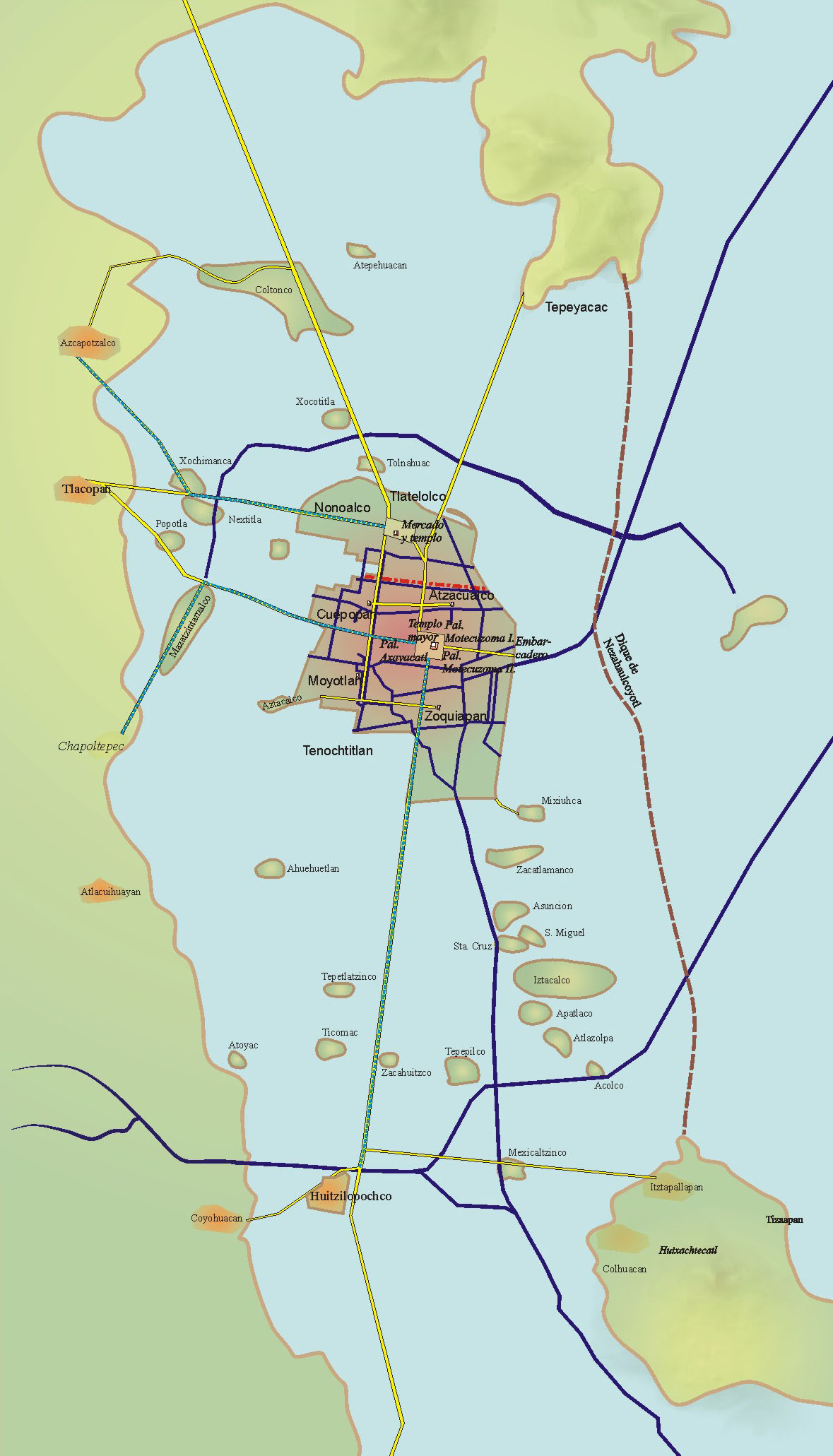|
Cacamatzin (tlacochcalcatl)
Cacamatzin was a 15th-century Aztec noble — the eldest son of the '' cihuacoatl'', Tlacaelel — and warrior who held the title of '' Tlacochcalcatl''. His mother was princess Maquiztzin.Chimalpahin (1997): pp. 48–49. He had twelve children, only three of whom are known:Chimalpahin (1997): pp. 140–141 *A female (name unknown), who married Nezahualpilli, the tlatoani of Texcoco. The pair had a son, named Cacamatzin after his grandfather, who succeeded his father as ruler of Texcoco. * Tlacaelel II, named after his grandfather, who also became '' cihuacoatl''.Chimalpahin (1997): pp. 54–55, 140–141. *Chicuey or Chicome Axochitzin, a warrior whose daughter became the mistress of Juan Rodríguez de Villafuerte, a Spanish conquistador. Cacamatzin was killed by the Purépecha The Purépecha ( ) are a group of Indigenous people centered in the northwestern region of Michoacán, Mexico, mainly in the area of the cities of Cherán and Pátzcuaro. They are also known ... [...More Info...] [...Related Items...] OR: [Wikipedia] [Google] [Baidu] |
Mexico Tenochtitlan
, also known as Mexico-Tenochtitlan, was a large Mexican in what is now the historic center of Mexico City. The exact date of the founding of the city is unclear, but the date 13 March 1325 was chosen in 1925 to celebrate the 600th anniversary of the city. The city was built on an island in what was then Lake Texcoco in the Valley of Mexico. The city was the capital of the expanding Aztec Empire in the 15th century until it was captured by the Tlaxcaltec and the Spanish in 1521. At its peak, it was the largest city in the pre-Columbian Americas. It subsequently became a '' cabecera'' of the Viceroyalty of New Spain. Today, the ruins of are in the historic center of the Mexican capital. The World Heritage Site of contains what remains of the geography (water, boats, floating gardens) of the Mexica capital. was one of two Mexica (city-states or polities) on the island, the other being . Etymology Traditionally, the name was thought to come from Nahuatl ("rock") ... [...More Info...] [...Related Items...] OR: [Wikipedia] [Google] [Baidu] |
Cacamatzin
Cacamatzin (or Cacama) (c. 1483–1520) was the tlatoani (ruler) of Texcoco,Diaz, B., 1963, The Conquest of New Spain, London: Penguin Books, the second most important city of the Aztec Empire. Cacamatzin was a son of the previous king Nezahualpilli by one of his mistresses. Traditionally, the Texcocan kings were elected by the nobility from the most able of the royal family. Cacamatzin's election to the throne in 1515 was said to have been made under considerable pressure from Moctezuma II Moctezuma Xocoyotzin . ( – 29 June 1520), retroactively referred to in European sources as Moctezuma II, and often simply called Montezuma,Other variant spellings include Moctezuma, Motewksomah, Motecuhzomatzin, Moteuczoma, Motecuhzoma, Motē ..., lord of Tenochtitlán. Moctezuma II wished to lessen Texcoco's power in favor of greater centralization in Tenochtitlán. Cacamatzin wrote ''Cacamatzin Icuic'' ("Song of Cacamatzin"), invoking his father and grandfather; he seems to pro ... [...More Info...] [...Related Items...] OR: [Wikipedia] [Google] [Baidu] |
15th-century Deaths
The 15th century was the century which spans the Julian calendar dates from 1 January 1401 (represented by the Roman numerals MCDI) to 31 December 1500 (MD). In Europe, the 15th century includes parts of the Late Middle Ages, the Early Renaissance, and the early modern period. Many technological, social and cultural developments of the 15th century can in retrospect be seen as heralding the " European miracle" of the following centuries. The architectural perspective, and the modern fields which are known today as banking and accounting were founded in Italy. The Hundred Years' War ended with a decisive French victory over the English in the Battle of Castillon. Financial troubles in England following the conflict resulted in the Wars of the Roses, a series of dynastic wars for the throne of England. The conflicts ended with the defeat of Richard III by Henry VII at the Battle of Bosworth Field, establishing the Tudor dynasty in the later part of the century. Consta ... [...More Info...] [...Related Items...] OR: [Wikipedia] [Google] [Baidu] |
Purépecha People
The Purépecha ( ) are a group of Indigenous peoples of Mexico, Indigenous people centered in the northwestern region of Michoacán, Mexico, mainly in the area of the cities of Cherán and Pátzcuaro. They are also known by the derogatory term "Tarascan", an exonym, applied by outsiders and not one they use for themselves. The Purépecha occupied most of Michoacán but also some of the lower valleys of both Guanajuato and Jalisco. Celaya, Acambaro, :es:Cerano, Cerano, and Yuriria, Yurirapundaro. Now, the Purépecha live mostly in the highlands of central Michoacán, around Lakes Lake Patzcuaro, Patzcuaro and Lake Cuitzeo, Cuitzeo. History Prehispanic history It was one of the major empires of the Pre-Columbian era. The capital city was Tzintzuntzan (Mesoamerican site), Tzintzuntzan. Purépecha architecture is noted for step pyramids in the shape of the letter "T". Pre-Columbian Purépecha artisans made feather mosaics that extensively used hummingbird feathers, which were hi ... [...More Info...] [...Related Items...] OR: [Wikipedia] [Google] [Baidu] |

